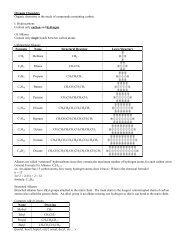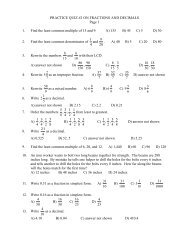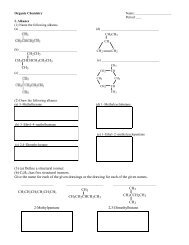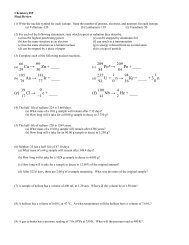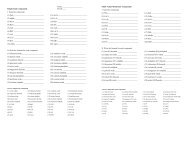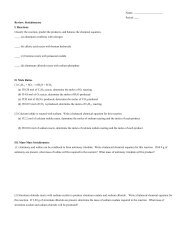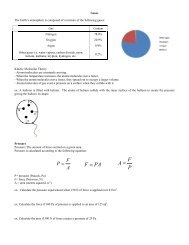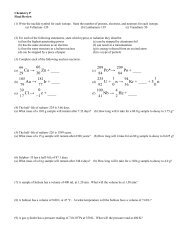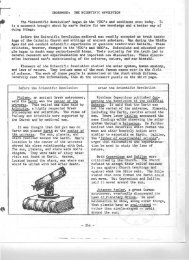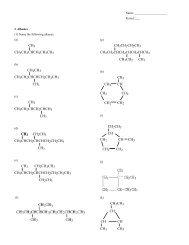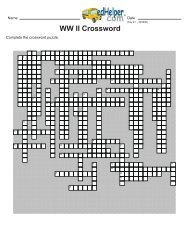Corporations gained more power due to SC rulings in the 1880s and 1890s that gave them thesame 14th <strong>Am</strong>endment protections as individuals. Pools: Basically, pools were “Gentlemen’s Agreements” between <strong>com</strong>panies that set limits onproduction and agreed to the sharing of profits. Since they depended on honesty, though, theirusefulness had already died by the time they were outlawed among RRDs in 1887. Trusts: Originated by Rockefeller, trusts relied on the principle that one <strong>com</strong>pany could controlanother by forcing it to yield control of its stock to the bigger <strong>com</strong>pany’s board of trustees. Thisallowed for horizontal integration, which was pioneered by Rockefeller in 1882 w/StandardOil [ex. take over all oil refineries]. Holding Companies: In 1888 New Jersey allowed corporations to own property in other statesand own stock in other corporations. This led to the holding <strong>com</strong>pany, which owned interest inother <strong>com</strong>panies and could help merge them. This led to vertical integration like GustavusSwift achieved w/meat processing [ex. take over all meat related industries].- So mergers were answer to the search for order and profits in the business world. The biggest corporationof the time was the US Steel Corporation, created by J.P. Morgan in 1901. Speaking of J.P., the mergermovement created those wonderful people we all know and love, the brokers, who specialized inengineering mergers. Everyone joined the investing frenzy; regulations were loosened, laissez-faire, etc.*The Effect of the Machine on Labor*- Mechanization obviously meant big changes for workers, who were forced to acclimate themselves to newfactory conditions that minimized their independence. Some significant trends included: The replacement of the producer by the employee: most workers no longer were their ownbosses. Instead, they were paid for time on the job. Specialization and the devaluation of skilled labor: workers in mass-production assembly linesfound themselves doing the same stupid little task over and over again instead of making theirown decisions about techniques, starting and stopping times, etc. Increased <strong>com</strong>pany control: in efforts to increase worker efficiency, employers tried toestablish temperance/reform societies and control workers’ social lives. Other employersbegan paying per item produced rather than by hour. Employment of women and children: as the need for skilled workers decreased, employers cutcosts by hiring women and children for assembly lines. Women also worked in the servicesector and in sales/secretarial positions. By 1900, some state laws limited the employment ofchildren, but many <strong>com</strong>panies still got away with it. Decreased independence: in addition to finding their actual jobs more constricting, workersfound that their wages were largely beyond their control and were often unable to find steadywork – i.e. they were trapped by the system. New threats at the workplace: workers encountered industrial accidents, etc.- So basically the machine gave the workers the crap end of the deal. Worse still, they weren’t allowed toorganize effectively as a result of a series of anti-labor decisions, and free-market views made it difficult forlegislation dealing with working hours and conditions to be passed.- Supreme Court cases dealing with labor regulation: Holden v. Hardy (1896) – Court upheld regulation on miners’ working hours Lochner v. New York (1905) – Court rejected regulation on bakers’ working hours b/c job notconsidered to be dangerous, interference w/contract = violation of Fourteenth <strong>Am</strong>endment Muller v. Oregon (1908) – Court upheld regulation on women laundry workers’ working hours,claiming that women needed special protection, led to laws banning women from occupations- Generally, though, workers did not make much progress, which led to the…*The Union Movement*- Important strikes/events relating to the Unions:1877: In July, Unionized RRD workers struck to protest wage cuts [b/c of Panic of 1873]. Thestrikes led to violence, which was broken up by state militia <strong>com</strong>panies hired by the employers.Strikebreakers were also hired. Finally Hayes sent federal troops to quell the unrest. After1877, the union movement really began picking up speed. Trade unions, which specialized inskilled workers in particular crafts, had been around for years, but no real organizations of nat’lscope survived the panic except for the Knights of Labor. Haymarket Riot [May 1, 1886]: In Chicago, several groups joined for the campaign for an 8-hour workday and organized mass strikes and labor demonstrations. Workers involvedincluded the craft unions as well as anarchists. Consequently, in response to an outbreak ofpolice brutality a bomb was set off in Haymarket Square [presumably by anarchists], resulting44
in the arrest of 8 immigrant radicals, some of who were pardoned. The HR led to increasedparanoia with respect to anarchism and labor. July 1892: AFL-affiliated Iron and Steelworkers Association went on strike in Pennsylvania,causing Henry Frick to close the plant and hire Pinkerton detectives to defend it. Although thestrikers eventually gave in, it gave the union more bad PR due to workers attacking, etc. Pullman Strike [1894]: To protest Pullman’s policies in his <strong>com</strong>pany town, workers walked outat the factory. Pullman would not negotiate, so workers for the <strong>Am</strong>erican Railway Union calleda strike. Pullman closed the factory; the Union [Eugene V. Debs] refused to handle Pullmancars; and finally a court injunction was used to stop the strike.- Important workers’ organizations: Knights of Labor: Founded in 1869 by Terence V. Powderly, the KOL wel<strong>com</strong>ed all unskilledand semiskilled workers on a nat’l level. The basic ideology of the KOL was pretty utopian: i.e.they wanted to get rid of capitalism in favor of a “cooperative workers’ alliance” in whichworkers worked for themselves. Consequently, the KOL refused to strike, b/c it would goagainst the “cooperative” idea. As a result of their cooperative policies, the KOL lost influence,esp. after, in 1886, a strike began among a sector of the KOL against RRD boss Jay Gould toprotest cut wages. Powderly met with Gould and called off the strike, but Gould would notconcede, so the militant unions began to quit the KOL, seeing it as weak. <strong>Am</strong>erican Federation of Labor: The AFL emerged as the major organization after 1866. Ledby Samuel Gompers, it avoided the KOL idealistic rhetoric, concentrated on concrete goals[higher wages, shorter hours, right to bargain collectively], and excluded unskilled workers andwomen. The AFL also avoided party politics. Industrial Workers of the World [IWW, “Wobblies”]: The IWW, which aimed to unite allworkers, was basically a socialist/anarchist organization that believed violence was justified tooverthrow capitalism. The organization finally collapsed in WWI.- Women in the Union movement: most Unions rejected women due to a fear of <strong>com</strong>petition [women wouldwork for lower wages] and sex segregation. Still, some women formed their own Unions, and in 1903 theWomen’s Trade Union League was founded. The WTUL encouraged protective legislation, education, andwomen’s suffrage – it was an important link between labor and the women’s movements.- Immigrants/AA in the Union movement: most Unions also rejected immigrants and African <strong>Am</strong>ericans b/cof lower wages, and prejudices were reinforced when blacks worked as strikebreakers.- REMEMBER only a portion of workers were in unions; job instability really made it hard for organizations toform effectively. Fraternal societies were also prevalent during the time.*Standards of Living*- Industrialization created the beginnings of the monster we now know as our fully <strong>com</strong>mercialized society.Formerly isolated <strong>com</strong>munities began to, through electricity and <strong>com</strong>munications, get access to good andservices. Status became more based on $ [more mobility]; but the gap between rich and poor grew.- In<strong>com</strong>es rose a lot, but then again so did prices. Working class families could hypothetically afford newstuff, but they would have had to find additional sources of in<strong>com</strong>e [i.e. subletting, child labor]. Overall,though, paid employment became more prevalent, leading to the growth of our <strong>com</strong>mercial society.- Some symptoms of <strong>com</strong>mercialization: higher life expectancy due to advances in medical care and betterdiets, more upwards mobility [education became key], flush toilets, processed and preserved foods, readymadeclothing, department and chain stores, and my personal favorite, advertising.*Ideologies of the Time*- So what do you say when many small businesses are being ruthlessly crushed by mega-big moguls? It’seasy! Social Darwinism, originally advocated by Herbert Spencer, was taken over by Yale professorWilliam Graham Sumner and stated that the survival of the fittest implied that the gov’t should stay out andlet the rightful winners take their share. Monopolies = natural accumulation of power.- To add on to that, there was the Andrew Carnegie Gospel of Wealth concept: wealth carries moralresponsibilities, and it’s good we moguls have it all b/c that way we can be the guardians of society. Gimmea break! Still, some industrialists did give a lot to charities.- It’s important to note that, though laissez-faire was the big concept, business leaders still pressed the gov’tfor assistance, which it provided in the form of tariffs on foreign goods [allowed them to raise prices],subsidies, loans, and tax breaks.- Naturally, all this activity didn’t go by unnoticed, and some people certainly spoke out against it, portrayingcorporations as greedy and voicing fears of monopolies.- Some favored gov’t regulation or even socialism: in 1883 sociologist Lester Ward appealed for gov’tintervention and a cooperative philosophy in Dynamic Sociology, in 1879 writer Henry George asked for a45
- Page 3 and 4: Congregationalists (Puritans) - The
- Page 5 and 6: - So the Restoration Colonies, form
- Page 7 and 8: - So in England, where they were lo
- Page 9 and 10: *Colonial Politics 1700-1750: Relat
- Page 11 and 12: - Another ideology that was beginni
- Page 13 and 14: - The Quebec Acts were passed aroun
- Page 15 and 16: - So, by 1782, what had seemed to b
- Page 17 and 18: on the economic side, since the gov
- Page 19 and 20: - Anyway, Congress had several ques
- Page 21 and 22: - Adams was still in the early Wash
- Page 23 and 24: *Political Factionalism and Jeffers
- Page 25 and 26: - Samuel Slater set up the first te
- Page 27 and 28: - Court rulings extended the powers
- Page 29 and 30: Revival, Reform and Politics during
- Page 31 and 32: - Anyhow, during his administration
- Page 33 and 34: TEXAS (Southerners) - Texas had bee
- Page 35 and 36: - Anyhow, Pierce’s total support
- Page 37 and 38: They had a smaller everything: smal
- Page 39 and 40: - The two Northern victories at the
- Page 41 and 42: - The result was the Fourteenth Ame
- Page 43: The Slaughter-House Cases (1873) -
- Page 47 and 48: case (1897 - ICC can’t set rates)
- Page 49 and 50: - The Populists prepared to run aga
- Page 51 and 52: - MOST IMPORTANTLY, though, was the
- Page 53 and 54: - So, what led the US to undertake
- Page 55 and 56: - The rebellion, led by Emilio Agui
- Page 57 and 58: - Still, Americans managed to turn
- Page 59 and 60: - So - the point of this episode? B
- Page 62 and 63: *Hoover’s Response*- Poor Herbert
- Page 64 and 65: - In FDR’s second term, however,
- Page 66 and 67: Dominican Republic - When we left i
- Page 68 and 69: World War II (1941 - 1945)*The Cour
- Page 70 and 71: - So Truman started off again all c
- Page 72 and 73: - First of all, the 1950s were (for
- Page 74 and 75: peace w/Japan that ended occupation
- Page 76: - France wanted out, so at the Gene



